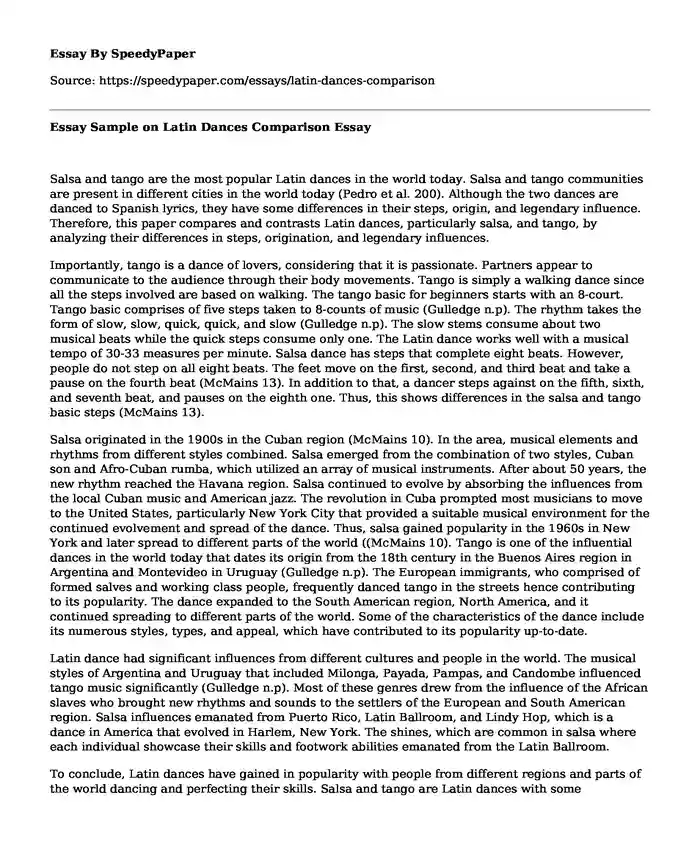Salsa and tango are the most popular Latin dances in the world today. Salsa and tango communities are present in different cities in the world today (Pedro et al. 200). Although the two dances are danced to Spanish lyrics, they have some differences in their steps, origin, and legendary influence. Therefore, this paper compares and contrasts Latin dances, particularly salsa, and tango, by analyzing their differences in steps, origination, and legendary influences.
Importantly, tango is a dance of lovers, considering that it is passionate. Partners appear to communicate to the audience through their body movements. Tango is simply a walking dance since all the steps involved are based on walking. The tango basic for beginners starts with an 8-court. Tango basic comprises of five steps taken to 8-counts of music (Gulledge n.p). The rhythm takes the form of slow, slow, quick, quick, and slow (Gulledge n.p). The slow stems consume about two musical beats while the quick steps consume only one. The Latin dance works well with a musical tempo of 30-33 measures per minute. Salsa dance has steps that complete eight beats. However, people do not step on all eight beats. The feet move on the first, second, and third beat and take a pause on the fourth beat (McMains 13). In addition to that, a dancer steps against on the fifth, sixth, and seventh beat, and pauses on the eighth one. Thus, this shows differences in the salsa and tango basic steps (McMains 13).
Salsa originated in the 1900s in the Cuban region (McMains 10). In the area, musical elements and rhythms from different styles combined. Salsa emerged from the combination of two styles, Cuban son and Afro-Cuban rumba, which utilized an array of musical instruments. After about 50 years, the new rhythm reached the Havana region. Salsa continued to evolve by absorbing the influences from the local Cuban music and American jazz. The revolution in Cuba prompted most musicians to move to the United States, particularly New York City that provided a suitable musical environment for the continued evolvement and spread of the dance. Thus, salsa gained popularity in the 1960s in New York and later spread to different parts of the world ((McMains 10). Tango is one of the influential dances in the world today that dates its origin from the 18th century in the Buenos Aires region in Argentina and Montevideo in Uruguay (Gulledge n.p). The European immigrants, who comprised of formed salves and working class people, frequently danced tango in the streets hence contributing to its popularity. The dance expanded to the South American region, North America, and it continued spreading to different parts of the world. Some of the characteristics of the dance include its numerous styles, types, and appeal, which have contributed to its popularity up-to-date.
Latin dance had significant influences from different cultures and people in the world. The musical styles of Argentina and Uruguay that included Milonga, Payada, Pampas, and Candombe influenced tango music significantly (Gulledge n.p). Most of these genres drew from the influence of the African slaves who brought new rhythms and sounds to the settlers of the European and South American region. Salsa influences emanated from Puerto Rico, Latin Ballroom, and Lindy Hop, which is a dance in America that evolved in Harlem, New York. The shines, which are common in salsa where each individual showcase their skills and footwork abilities emanated from the Latin Ballroom.
To conclude, Latin dances have gained in popularity with people from different regions and parts of the world dancing and perfecting their skills. Salsa and tango are Latin dances with some differences in their steps, origin, and influences. As discussed in this paper, salsa originated in the 20th century and gained popularity in the 1960s. Tango originated in the late 19th century and gained popularity in the 20th century. The influences varied with tango gaining influence from immigrants and former slaves in Europe while salsa gained influence from the Puerto Rico and Latin Ballroom. Tango and salsa have eight rhythmic steps but in salsa step four and step eight are pauses. Thus, this shows the differences between two Latin dances, salsa and tango.
Works Cited
McMains, Juliet E. Spinning Mambo into Salsa: Caribbean Dance in Global Commerce. , 2015. Print.
Pedro, Rachel, et al. "Creating a Cultural Dance Community of Practice: Building Authentic Latin American Dance Experiences." Research in Dance Education, vol. 19, no. 3, 5 June 2018, pp. 199-215, doi. 10.1080/14647893.2018.1476479.
Gulledge, Steph. "A Brief History of Tango." The Slow Road Luxury Travel Blog, 2016, www.butterfield.com/blog/2016/06/10/brief-history-tango/
Cite this page
Essay Sample on Latin Dances Comparison. (2023, Mar 29). Retrieved from https://speedypaper.com/essays/latin-dances-comparison
Request Removal
If you are the original author of this essay and no longer wish to have it published on the SpeedyPaper website, please click below to request its removal:
- Book Review Essay Sample: Candide by Voltaire
- Free Essay with Google SWOT Analysis
- Essay Sample: Threats to Home Security
- Paper Example on Nosocomial Infection With Urinary Catheter-Associated Urinary Tract Infection
- Essay Sample on Open Government Implementation
- Free Essay: Where Policy Decisions Should Be Made
- Susie King Taylor's Account. Paper Example
Popular categories





